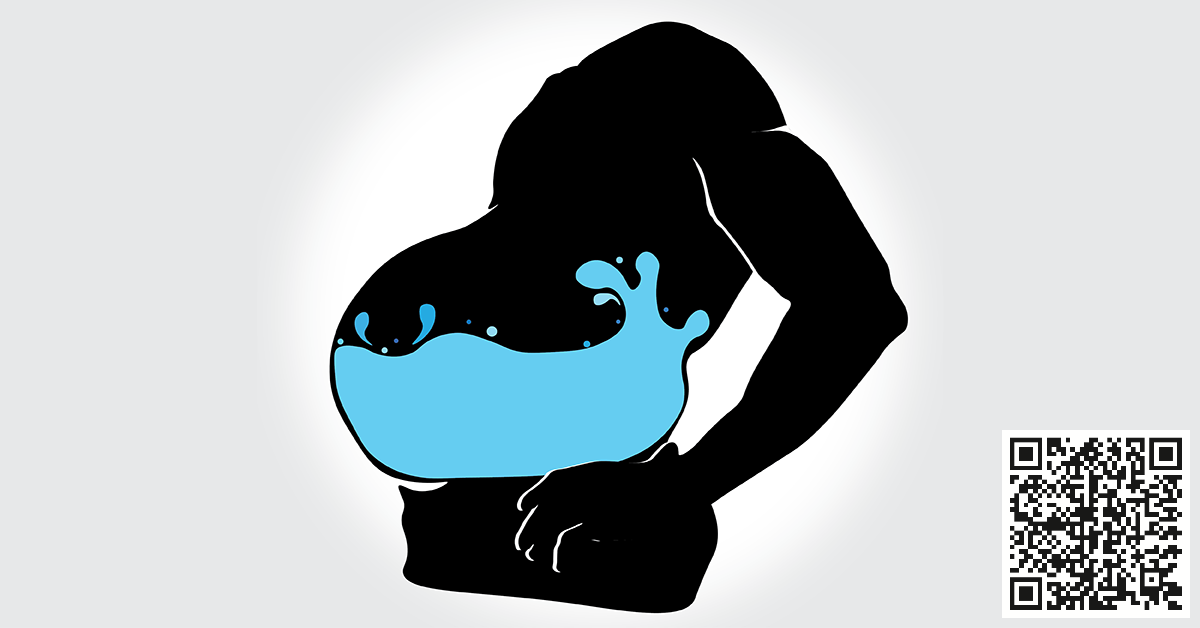‘Ascites’ (pronounced uh·sai·teez) is abnormal accumulation of fluid within the tummy (abdomen).
This article gives you a general overview of ascites, including the causes, associated symptoms and complications. It is presented in two parts:
- The first part is a poem that gives a summary of ‘ascites’.
- The second explains this poem, line-by-line.
An audiovisual presentation of the poem is shown below:
Ascites: abnormal fluid accumulation in the tummy
When the abdomen is enlarging,
not the gradual kind with ageing,
or pregnancy, or feeding,
but with sloshy feeling, like organs floating
It may be fluid build-up in the tummy, ‘ascites’,
caused by cirrhosis, pancreatitis,
cancer, TB, kwashiorkor or serositis
and may occur with swollen extremities
As massive fluid starts accumulating,
there may be difficulty in breathing
and if the heart is failing,
exercise intolerance with wheezing
History helps diagnosis,
like diet or cough in tuberculosis,
alcoholism in cirrhosis,
or evidence of cancer or metastasis
Doctor may take sample by paracentesis
for albumin and bacterial analysis,
prescribe diuretics and diet for diuresis
and request tests for suspected causes
Hepatorenal syndrome is a complication,
as well as peritoneal inflammation
Ascites refractory to medication,
is an indication for liver transplantation
Ascites, explained
Stanza 1 (Introduction)
“When the abdomen is enlarging,” (stanza 1, line 1)
The space within the tummy(abdomen) where organs like the stomach, intestines, liver, spleen and pancreas are located is called the ‘peritoneal cavity‘.
Some of these organs are in contact with one another so the body produces a type of fluid (peritoneal fluid) that helps to reduce friction between them.
Normally, the peritoneal cavity contains about 50-75 mls of fluid; that is about 1/4 of a cup.
In ascites, fluid accumulates and may be up to several liters; more than 30 liters has been recorded.
As this ‘abnormal’ fluid accumulates, the tummy starts to get bigger.
Ascites is also called hydroperitoneum or abdominal dropsy.
“not the gradual kind with ageing,” … “or pregnancy, or feeding,” … “but with sloshy feeling, like organs floating” (stanza 1, lines 2, 3 & 4)
The increase in size of the tummy as fluid accumulates, is different from the belly fat that increases with age.
It is also different from the enlarging tummy of pregnancy or when you eat a lot of food.
In ascites, as the fluid collection increases, you may have the feeling that there is ‘water’ in your tummy, which some have described as “sloshy”.
Stanza 2 (causes of 'ascites' and associated symptoms)
“It may be fluid build-up in the tummy, ‘ascites’,” … “caused by cirrhosis, pancreatitis,” … “cancer, TB, kwashiokor or serositis” (stanza 2, lines 1, 2 & 3)
Ascites is found in cirrhosis, pancreatitis, tuberculosis, kwashiokor, serositis and so on.
- Long term alcohol abuse as well as Hepatitis B and C virus infections frequently lead to ‘cirrhosis’ (scar tissue replaces healthy liver tissue). This means that the liver cannot function normally; as a result, fluid collects in the ‘peritoneal cavity’.
- Cancer may affect the peritoneum directly or spread to the peritoneum from other organs like the lungs, breasts and ovaries, which may lead to ascites.
- Abdominal tuberculosis is a very important cause of ascites in the developing world. ‘Bovine tuberculosis’ can spread from cattle to humans from ingesting infected raw milk or meat. This is a story of one such case: “How my Stupid Love for Suya, almost killed Me“.
- Other important causes of ascites include heart failure and kwashiorkor (in malnourished children).
“and may occur with swollen extremities” (stanza 2, line 4)
The extremities refers to the arms and legs.
In some cases, as fluid accumulates in the tummy, there is also retention of fluids in the extremities, for example in ‘Nephrotic syndrome’ and ‘Hereditary angioedema’.
Cirrhosis, heart failure and kwashiokor are associated with more of fluid accumulation in the legs, called ‘pedal edema’.
Stanza 3 (associated symptoms continued)
“As massive fluid starts accumulating,” … “there may be difficulty in breathing;” (stanza 3, lines 1 & 2)
Fluid may build up to the extent that it impinges on the diaphragm and prevents normal expansion of the lungs; of course, this may lead to difficulty in breathing.
“and if the heart is failing,” … “exercise intolerance, with wheezing” (stanza 3, lines 3 & 4)
I stated above that pedal edema occurs with ascites in some conditions. Other causes of ascites also have symptoms and signs that help the doctor to make a diagnosis, for example, a person whose heart is failing may present with ‘exercise intolerance’ with wheezing’.
- ‘exercise intolerance’ is when a person is not able to carry out physical activity at a level which one would normally expect of him or her, considering the person’s age, size, sex or muscle mass.
- ‘Wheezing’ is a sound that is like whistling, while breathing.
Stanza 4 (importance of history in diagnosis of 'ascites')
“History helps diagnosis,” … “like diet or cough in tuberculosis,” … “alcoholism in cirrhosis” … “or evidence of cancer or metastasis” (stanza 4, lines 1 to 4)
History is the story that you tell the doctor about how your condition has progressed.
You will help the doctor to narrow down your diagnosis if you volunteer a history of how you consumed raw (unpasteurized) milk or significant amounts of alcohol for over 10 years.
NOTE: Ascites that results from tuberculosis may be from diet, in which case there will likely be no cough. On the other hand, tuberculosis that affects the lungs primarily could spread to the abdomen when the patient swallows infected sputum, or directly through the blood. In this second scenario, there is usually a history of long term cough.
In many cases of cancer, the first obvious symptom may be significant weight loss.
Stanza 5 (diagnosis and treatment)
“Doctor may take sample by paracentesis,” … “for albumin and bacterial analysis,” (stanza 5, lines 1 & 2)
These lines talk about the procedure (paracentesis) used to take a sample of fluid that has collected in the tummy.
Paracentesis is important for making a diagnosis as well as to relieve pressure symptoms like difficulty in breathing.
Albumin, bacteria, glucose, white blood cells (WBCs) and lactate dehydrogenase (LDH) are important, and their presence or quantity helps to guide diagnosis.
Ultrasound and CT scan are also useful in detecting and quantifying the amount of accumulated fluid.
“prescribe diuretics and diet for diuresis” … “and request tests for suspected causes” (stanza 5, lines 3 & 4)
The treatment of ascites may start even before the doctor confirms the diagnosis, for example, by carrying out paracentesis to relieve pressure symptoms, which I stated above.
If the accumulated fluid is not so massive, or as an adjunct to paracentesis, the doctor may prescribe diuretics, which are drugs that help the body to loose water by urination. Diuretics are also called ‘water pills’.
Diet that helps diuresis, which is the increased production of urine, is also important; an example of this is ‘salt-restricted’ diet, which is the consumption of very low, to zero amounts of salt.
Other tests that the doctor requests for, depend on findings from history, physical examination and results of initial tests.
Stanza 6 (complications)
“Hepatorenal syndrome is a complication,” … “as well as peritoneal inflammation,” … “Ascites refractory to medication” … “is an indication for liver transplantation” (stanza 6, lines 1 to 4)
I stated earlier that ascites is a feature of diseases like cirrhosis, cancer, tuberculosis and others; this implies that complications associated with ascites is also a pointer to the complications of those diseases.
Such complications include:
- Hepatorenal syndrome (HRS), which is rapid deterioration of kidney function, following advanced liver disease.
- Spontaneous Bacterial Peritonitis (SBP), which is inflammation of the peritoneum, due to the presence of bacteria in ascitic fluid.
- NOTE: The peritoneum is a thin layer of tissue that defines the boundaries of the peritoneal cavity which I discussed above.
- Spontaneous Fungal Peritonitis (SFP), which is inflammation of the peritoneum due to the presence of fungi in ascitic fluid.
These complications lead to death and if medical treatment is not effective, liver transplantation may be the last resort.
Conclusion
Ascites is abnormal fluid accumulation in the tummy (abdomen) and is caused by conditions like cirrhosis, cancer and tuberculosis.
This fluid accumulation may make the tummy to enlarge significantly to the point that it affects breathing.
Asides the tummy, fluid accumulation may also affect the arms and legs.
The condition may be treatable, depending on the underlying cause but if complications occur, there may be need for liver transplantation.




